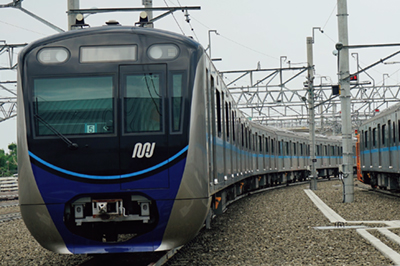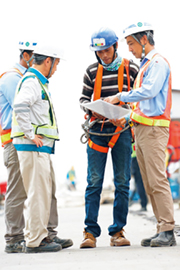Stories from the Field 5
An All-Japan Effort Realizes the First Subway in Indonesia
- Changing Jakarta’s urban transportation with Japanese technology -

The Jakarta MRT train (Photo: JICA)

Japanese and Indonesian engineers having a meeting during construction (Photo: JICA)
In March 2019, the Jakarta Mass Rapid Transit (MRT) opened for service in Jakarta, the capital of Indonesia. The Jakarta MRT is the first “All-Japan” subway system project in Southeast Asia. Funded by a Japanese ODA loan over a span of approximately 13 years, the Jakarta MRT was constructed through Japan’s total support in basic design, construction, and introduction of transportation systems, including the introduction of trains, signals, and gate systems, as well as their operation and maintenance (O&M). Japanese technology and operating know-how were introduced throughout the project.
Over the past 20 years, there has been a dramatic increase in the number of motorcycles and automobiles in Jakarta. It has increased around 14 times and three times, respectively. This has led to severe traffic congestion, air pollution, and an increase in traffic accidents, causing major damages to people’s lives and the economy. Therefore, the establishment of a public transit network was an urgent challenge for Jakarta, that expects to see continuing population growth.
The MRT, which can transport a large number of people accurately, was highly expected to be a solution to the aforementioned issue. The section of the MRT that has opened for service this time is part of the “North-South” line, which connects central Jakarta with the southern residential district and covers a distance of about 15.7 kilometers. The line travels underground for 5.9 kilometers, and over elevated rails for 9.8 kilometers, stopping at 13 stations over its approximately 30-minute trip. The opening of the North-South line allows people to reach central Jakarta in just 30 minutes from the southern residential district, which previously took an hour and a half.
Mr. ADACHI Hiroaki of JICA describes the changes the MRT brought to the traffic situation in Jakarta as follows.
“The most appealing point of the MRT is its operating punctuality, which is as accurate as the Japanese rail system. People can now arrive at their destination on-time, without being affected by traffic jams and other conditions. The MRT is also defined by its clean and well-kept stations and trains, due to the efforts of the operating company, inspired by Japan.”
The MRT features the first signal system in Indonesia, the Communications-Based Train Control (CBTC), and an automatic-driving system. The system allows the trains to stop at stations and open their doors automatically, and on the main line, the drivers only need to close the doors and start the train. Currently, the trains operate at five-minute intervals during rush hours and ten-minute intervals at other times of the day, and have achieved more than 99% operating punctuality since opening its service in April. It is truly a railway established by Japanese advanced technology and systems.
With regard to the interior of the MRT, the seats are made of plastic in order to reduce maintenance work, and eating and drinking is not allowed to preserve a clean and hygienic interior. However, since the majority of the Indonesian population is Muslim, during the month-long Ramadan fasting period, the train makes an announcement at sunset informing, “Dates and water may be consumed in the train cars to break the fast, but all garbage should be taken home.” This is a result of giving primary consideration to Indonesian culture in the operation of the MRT.
Mr. Adachi recounts the most difficult challenge in constructing the MRT.
“Construction management was particularly difficult. Land procurement for the stations and elevated rail did not proceed well, causing a major delay in the initial plan.”
In order to overcome the challenge, Jakarta MRT, the local operating company, Japanese construction companies managing construction, companies responsible for facility layout, and consultants in charge of construction supervision and employee training cooperated closely and carried out their respective work in parallel. Thus, after numerous changes of plans, the MRT was finally able to open for service in March 2019.
The MRT was the first subway in Indonesia, and the operating company Jakarta MRT had no experience beforehand. Ms. UTSUNOMIYA Mariko, deputy head of the technology department at Japan International Consultants for Transportation Co., Ltd., which provided operation and maintenance support shared the philosophy behind their role.
“In the future, it will be the local staff of Jakarta MRT who will have to manage this railroad and respond if an accident occurs. The Japanese way of doing things will not always be applicable here. For these reasons, we placed an importance on their autonomy when transferring the technology and operation know-how to the local staff.”
The opening of the MRT brought about a transformation in the lifestyles of the people living in Jakarta. Above all, the MRT has become widely recognized among users as a convenient form of transportation that allows them to arrive at their destination quickly without getting caught in traffic jams. A new style of transit was also born, wherein people use local buses or motorcycle taxis to travel between their homes and the station, and then travel to their destination by the MRT. Local buses, which served as the primary form of public transport before the opening of the MRT, are adjusting their routes to include the MRT stations, and motorcycle taxi pick-up stations are being established in front of the MRT stations. A major challenge going forward will be how the MRT fuses with the existing forms of transportation in the city. Mr. Adachi shared his vision for the future.
“Although Jakarta is as large as the 23 wards of Tokyo, in the near future, the population is expected to exceed 35 million people, including those living in the surrounding suburbs. In this context, further expansion of the MRT is critical. Tokyo has approximately 300 kilometers of subway lines, but Jakarta has only just opened service on 15.7 kilometers. We have only reached the starting line.”
Going forward, expectations toward the best Japanese railway technology and operation know-how will continue to grow to address the traffic issues of Jakarta and to offer a new lifestyle to the city’s citizens.
<< Previous Page Next Page >>
Main Text | Reference Statistics | Stories from the Field | Master Techniques from Japan to the World | ODA Topics
